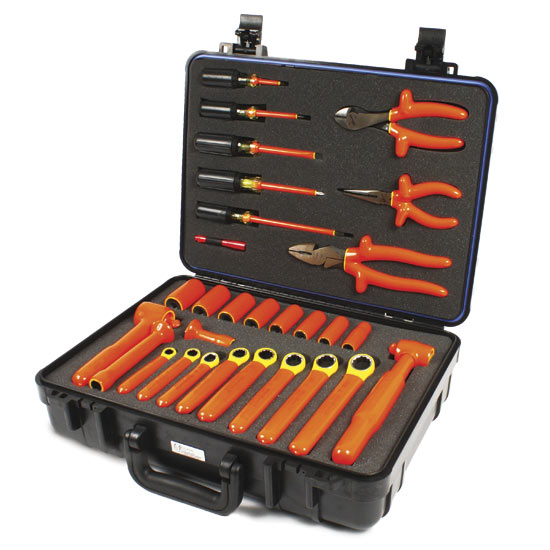Tec-Alert Newsletter
Electrical Safety Overview
 Electrical safety is an extremely important topic to discuss no matter what your field or occupations. Whether you are just working around your home or on the job performing your typical installs or repairs, knowledge of electrical currents and the potential hazards while working with or near electrical currents could save your life or the life of someone around you.
Electrical safety is an extremely important topic to discuss no matter what your field or occupations. Whether you are just working around your home or on the job performing your typical installs or repairs, knowledge of electrical currents and the potential hazards while working with or near electrical currents could save your life or the life of someone around you.
In this article, we highlight some general safety tips, OSHA insulated tool requirements and list several work related precautions important to know when working near electricity.
• Electrical safety is an extremely important topic to discuss no matter what your field or occupations. Whether you are just working around your home or on the job performing your typical installs or repairs, knowledge of electrical currents and the potential hazards while working with or near electrical currents could save your life or the life of someone around you.
In this article, we highlight some general safety tips, OSHA insulated tool requirements and list several work related precautions important to know when working near electricity.
According to the U.S. National Safety Council, over 10,000 workers every year are killed in U.S. industrial accidents. Approximately 4% of those accidents involve electricity. Common electrical currents in residential and commercial buildings have enough power to cause electrocution and death. Even changing a light bulb without unplugging the lamp could cause death if the live or hot socket has made contact with the person.
 |
|
The use of insulated tools greatly reduces the risk of shorts, shock and electrocution in hazardous situations
|
According to the U.S. National Safety Council, over 10,000 workers every year are killed in U.S. industrial accidents. Approximately 4% of those accidents involve electricity. Common electrical currents in residential and commercial buildings have enough power to cause electrocution and death. Even changing a light bulb without unplugging the lamp could cause death if the live or hot socket has made contact with the person.
Electrical current uses the human body as a conducting pathway and in the process can shock all involuntary muscles, including the heart, throughout your body possibly resulting in a fatality.
It is important to note that making direct contact with an electrical current is not the only way to be severely injured. Electricity can also arc or jump through the air to an individual using the body as a path to the ground. Thermal burns can occur from the heat generated by the arc as a heat flash or fire produced by the heat. High voltage contact burns can burn tissue internally and have no sign on the outside. Another possible form of injury is falling from a ladder or scaffold after having a startle reaction.
Safety Tips
• Always work with a partner.
Even when working on batteries or other low-voltage systems (50-150 Volts), always work with a partner. The partner’s job is to be available to switch off the power source, immediately call for help and save your life if an accidental shock occurs. This is known as the “Two Person Rule”.
• Work at a safe distance from all power lines.
OSHA requirements state that certain pieces of equipment must be kept at least 10 feet from power lines of 50,000 volts or less. If working around higher voltage, contact your local power company for OSHA minimum approach distance requirements. If you are in a vehicle or machinery that comes into contact with a power line, always remember to try to drive it away unless you are putting yourself or others in jeopardy. If you need to jump, remember to not touch the vehicle and jump as far away as possible landing on both feet together.
• Be aware of out of sight and buried electrical hazards.
Remember to look overhead to keep a good distance while working under power lines. Also remember electricity is often buried in cabling underground as well. Call before you dig to make sure you do not sever underground lines.
• Protect yourself with protective equipment.
Always wear protective eyewear to protect from electrical arcs. Have as little exposed skin as possible if near electrical currents. Insist on using and investing in insulated tools, gloves and blankets and inspect them often to ensure full performance.
Additional Work-Related Precautions
The safety guidelines below are an excellent guide for taking necessary precautions while repairing consumer and industrial equipment.
Safety Guidelines for High Voltage and/or Line Powered Equipment
Author: Samuel M. Goldwasser
Copyright (c) 1994, 1995, 1996, 1997, 1998
All Rights Reserved
http://www.repairfaq.org/REPAIR/F_safety.html
• Don't work alone - in the event of an emergency another person's presence may be essential.
• Always keep one hand in your pocket when anywhere around a powered line-connected or high voltage system.
• Wear rubber bottom shoes or sneakers.
• Wear eye protection - large plastic lens eyeglasses or safety goggles.
• Don't wear any jewelry or other articles that could accidentally contact circuitry and conduct current, or get caught in moving parts.
• Set up your work area away from possible grounds that you may accidentally contact.
• Know your equipment: TVs and monitors may use parts of the metal chassis as ground return yet the chassis may be electrically live with respect to the earth ground of the AC line. Microwave ovens use the chassis as ground return for the high voltage. In addition, do not assume that the chassis is a suitable ground for your test equipment!
• If circuit boards need to be removed from their mountings, put insulating material between the boards and anything they may short to. Hold them in place with string or electrical tape. Prop them up with insulation sticks - plastic or wood.
• If you need to probe, solder, or otherwise touch circuits with power off, discharge (across) large power supply filter capacitors with a 2 W or greater resistor of 100-500 ohms/V approximate value (e.g., for a 200 V capacitor, use a 20K-100K ohm resistor).
Monitor while discharging and/or verify that there is no residual charge with a suitable voltmeter. In a TV or monitor, if you are removing the high voltage connection to the CRT (to replace the flyback transformer for example) first discharge the CRT contact (under the insulating cup at the end of the fat red wire). Use a 1M-10M ohm 1W or greater wattage resistor on the end of an insulating stick or the probe of a high voltage meter. Discharge to the metal frame which is connected to the outside of the CRT.
• For TVs and monitors in particular, there is the additional danger of CRT implosion - take care not to bang the CRT envelope with your tools. An implosion will scatter shards of glass at high velocity in every direction. There is several tons of force attempting to crush the typical CRT. Always wear eye protection.
• Connect/disconnect any test leads with the equipment unpowered and unplugged. Use clip leads or solder temporary wires to reach cramped locations or difficult to access locations.
• If you must probe live, put electrical tape over all but the last 1/16" of the test probes to avoid the possibility of an accidental short which could cause damage to various components. Clip the reference end of the meter or scope to the appropriate ground return so that you need to only probe with one hand.
• Perform as many tests as possible with power off and the equipment unplugged. For example, the semiconductors in the power supply section of a TV or monitor can be tested for short circuits with an ohmmeter.
• Use an isolation transformer if there is any chance of contacting line connected circuits. A Variac(tm) (variable autotransformer) is not an isolation transformer! However, the combination of a Variac and isolation transformer maintains the safety benefits and is a very versatile device. See the document "Repair Briefs, An Introduction", available at this site (http://www.repairfaq.org), for more details.
• The use of a GFCI (Ground Fault Circuit Interrupter) protected outlet is a good idea but will not protect you from shock from many points in a line connected TV or monitor, or the high voltage side of a microwave oven, for example. (Note however, that, a GFCI may nuisance trip at power-on or at other random times due to leakage paths (like your scope probe ground) or the highly capacitive or inductive input characteristics of line powered equipment.) A fuse or circuit breaker is too slow and insensitive to provide any protection for you or in many cases, your equipment. However, these devices may save your scope probe ground wire should you accidentally connect it to a live chassis.
• When handling static sensitive components, an anti-static wrist strap is recommended. However, it should be constructed of high resistance materials with a high resistance path between you and the chassis (greater than 100K ohms). Never use metallic conductors as you would then become an excellent path to ground for line current or risk amputating your hand at the wrist when you accidentally contacted that 1000 A welder supply!
• Don't attempt repair work when you are tired. Not only will you be more careless, but your primary diagnostic tool - deductive reasoning - will not be operating at full capacity.
• Finally, never assume anything without checking it out for yourself! Don't take shortcuts!
OSHA Insulated Tool Requirements:
When working near or on high voltage circuits or power lines, OSHA has developed many safety guidelines to protect at risk personnel. Some of these guidelines mandate the use of insulated handling equipment, hand tools and power tools, when working near EXPOSED energized conductors or circuit parts.
OSHA defines "insulated" as, "separated from other conducting surfaces by a dielectric substance or air space permanently offering a high resistance to the passage of current and to disruptive discharge through the substance or space". This requirement includes screwdrivers, pliers, protected shields, ropes, etc. to be insulated if there might be any form (accidental) of contact with the energized conductors or circuit parts. This requirement should be applicable to electrical systems (including batteries) that have a nominal voltage greater than or equal to 50 volts line to ground for alternating and direct current. OSHA has stated that if the manufacturer has labeled the product insulated, then the tools are insulated up to the voltage on the manufacturer label with no additional approval necessary. This is defined in article 29 CFR 1910.399.
Tecra Tools carries a complete selection of insulated tools, high voltage gloves and insulating blankets from superior manufacturers such as Cementex, Wiha and Knipex. We offer Cementex products as our most complete insulated tool provider.
From screwdrivers, nutdrivers and pliers to socket sets, we have what you need to protect your employees from electrical shock. Check out our Cementex Insulated tool kit which is a basic set to get you started. If you don't find what you are looking for in our website, please give us a call.
For additional information related to OSHA Personal Protection Guidelines for Electrical Safety, please refer directly to the OSHA site by clicking here.
Go back to Tec-Alert
Return to Top of Page
BUILD YOUR OWN TOOL KIT
Subscribe to our Tec-Alert Email Newsletter
Get tips & information for field service and MRO professionals.
